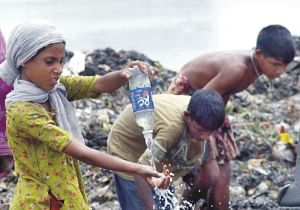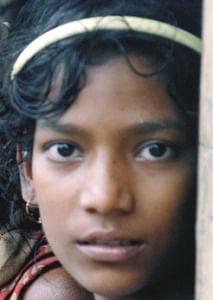Law Vision
Rights of girl child and ground reality
Md Mokaddas
Bangladesh is a country with evenly distributed male and female population. From the very beginning of its journey as an independent country it has been cherishing of harmonised growth of both male and female population. But it is far behind in materialising the envisaged goals for male population even, let alone for female population although history provides that our women played no less a role than the males in the junctures of the nation including achievement of independence. Till date their immense and outstanding contributions in the areas of family care, birth control, infant care and nutrition and even in generating income have been proved indispensable. But the expert discussants in the  discourses organised by various government and non-government organisations on different occasions delineate the pale picture of the girl children and women of our country. They tell of the destitute social status of women in our country and what we should really do has become the core question now-a-days. The experts underscore on the various measures to be undertaken to ameliorate their distressing conditions.
discourses organised by various government and non-government organisations on different occasions delineate the pale picture of the girl children and women of our country. They tell of the destitute social status of women in our country and what we should really do has become the core question now-a-days. The experts underscore on the various measures to be undertaken to ameliorate their distressing conditions.
As per Article 28(2) and 28(4) our constitution guarantees equal rights and equal opportunities for women. Vienna Declaration and Programme of Action, where Bangladesh is a signatory, mentions that national and international mechanisms and initiatives should be strengthened for the defence and protection of children, in particular the girl child. Beijing Declaration where also Bangladesh is a signatory, emphasised to ensure human rights of girl child as an inalienable, integral and indivisible part of all human rights and fundamental freedoms. Despite all these, women in Bangladesh are subjugated, marginalised, deprived and subjected to violence within and beyond family perimeter. Number of causes contribute to the continuation of this situation and we must be more attentive to redress these phenomena.
Though there exists a law debarring girls' matrimony below age 18 in Bangladesh, statistics provided by UNFPA reveal that the average matrimonial age of girls in Bangladesh is only 16.9 years and 51 percent of them get married at puberty and 60 percent of these girls become mother before 19. This sort of immature motherhood is increasing birth and death rate, genital damage, obstetric complicacies etc. The most important is what AKM Nur-un Nabi, Professor or Population Science Department of Dhaka University, says that due to early marriage a girl even fails to preserve her reproductive right, she fails to take decision when and how many children she will take because getting married immature with inadequate education constricts her decision making power within her new household. In the prevailing socio-economic conditions of Bangladesh the imperative is the ubiquitous preaching and propaganda in favour of timely marriage and educating the people in this respect by the intellectuals, politicians, other civil society members along with planned and organised initiatives by the GOs and NGOs rather than enacting laws rampantly. Bangladesh's feeble effort, evidenced by pale statistics, has got to be strengthened all out to surmount the daunting consequences of early marriage.
Poverty has been a deciding factor in Bangladesh. It compels parents to keep malnourished or undernourished their children, and especially the girl children are subject to more undernourishment traditionally. These undernourished girls grow up with multifarious deficiencies and again under go reproduction system giving birth to more vulnerable child and these threaten dire consequences in the days to come. Only masterly designed all out concerted programme has to be taken with utmost priority vis-à-vis the burning issue of poverty alleviation.
Comparing the 12 percent women literacy rate under age 15 in the year 1970 with 41 percent in the year 2004 one of course finds success in women education. But is it a significant statistics after 35 years of independence? Again mere literacy can contribute insignificantly in ameliorating the status of women especially in the context of Bangladesh where customs, tradition, religious obligations, patriarchy, social values and above all superstitions still play significant role in decision making regarding women affairs in family. Now time has come to be more practical in designing our educational texts both for formal and non-formal classes. Reproductive health care and child care is still a far cry in our text. But time is running out fast to include these in our curricula in a pragmatic way to denounce all negative perceptions.
In a patriarchal society like ours it has become a custom that the women in family are to eat less than men which is equally applied in case of children. The consequence is malnourished mother. Helen Keller International (HKI) Bangladesh, in its survey report (1999) on iron deficiency described that 52.7 percent of Bangladeshi children between age 6-59 months suffer from anaemia and at puberty suffer from stunting. Approximately 70 percent are victims of iodine deficiency. These children experience mental impairment, middle age diabetes and heart disease due to chronic susceptibility to metabolic disorders. The cumulative impact of malnutrition of girls is reflected in the high maternal mortality rate, low birth weight of baby, high child mortality and high fertility rate. To prevent nutritional shortage in child care breast feeding, ensuring regular dosage of vitamin A, iron, zinc and calcium can be much effective. To ensure nutrition in adolescence we need the knowledge of nutrition science which can help parents to ensure balanced food within their capability. And we desperately need to include nutrition science from primary level to at least higher secondary level of education and disseminate this knowledge of nutrition among the common mass by continuous propaganda in electronic and print media, distributing leaflet, organising non-formal education through GOs and NGOs etc.
Violence to women, both inside and beyond family ambit, in Bangladesh has been frequent and more perilous is that such incidents are on spate. The statistics of March 2005 only is  enough to reveal the agonising picture of violence against and subjugation of women in Bangladesh. In March last year 605 women had become victims of violence of which 99 faced rape, 35 were gang rapped, 11 were strangulated after rape, 22 fell under trafficking, 11 faced sexual harassment, 113 faced physical torture, 29 were kidnapped, 5 were doomed by dowry, 4 were sold to brothel, 2 were burnt, 6 were harassed by police and rest were tortured in different ways. According to World Population Fund (WPF) 47 percent of women in Bangladesh are subject to violence by men. Not only adult women, violence to girl children are also teeming which is really dreadful. The statistics could be most grave should all the incidents came to light which experts guess not revealed by the victims apprehending social humiliation and threat from perpetrators. Introduction of more stringent laws and its sterner implementation, stopping patronisation of such culprits in political banner, denouncing these culprits socially and introduction of women human rights and its positive impact in education system could be most effective options to rein in the spree of such crimes.
enough to reveal the agonising picture of violence against and subjugation of women in Bangladesh. In March last year 605 women had become victims of violence of which 99 faced rape, 35 were gang rapped, 11 were strangulated after rape, 22 fell under trafficking, 11 faced sexual harassment, 113 faced physical torture, 29 were kidnapped, 5 were doomed by dowry, 4 were sold to brothel, 2 were burnt, 6 were harassed by police and rest were tortured in different ways. According to World Population Fund (WPF) 47 percent of women in Bangladesh are subject to violence by men. Not only adult women, violence to girl children are also teeming which is really dreadful. The statistics could be most grave should all the incidents came to light which experts guess not revealed by the victims apprehending social humiliation and threat from perpetrators. Introduction of more stringent laws and its sterner implementation, stopping patronisation of such culprits in political banner, denouncing these culprits socially and introduction of women human rights and its positive impact in education system could be most effective options to rein in the spree of such crimes.
In spite of our two major political parties being headed by women for more than two decades and they have been ruling the government and the opposition for last fifteen years, empowerment of women in Bangladesh still seems a far cry and needs a long way to go. Number of women in the decision-making apex body of all the parties including major two is negligible. Only 2 percent lawmakers are directly elected in the National Parliament and recently a Bill to create 45 reserved seats for the women in parliament has been passed by the present parliament and these women MPs are to be selected by the directly elected MPs. Though since the last local government election during AL government about 13,000 women representatives have been elected directly, they do not enjoy the same status like the men firstly because these are reserve seats and secondly and mostly due to our patriarchal attitude. Not only this, some of these elected women local government representatives also experienced different sorts of repressions including sexual harassment from political foe and by antisocial hoodlums. Nevertheless, election of such a good number of women in local government bodies is significant in empowerment of women in Bangladesh.
Women leaders and experts have been urging and pursuing for more bold steps like direct quota-free elections for the women in all sectors and levels including parliament. They demand for more women nominations by the political parties in all tiers of elections. And the political parties got the national obligation to take the bold steps in this connection. Alongside vicious circle of poverty, extortion, social negative view and superstitions and subsequent malnutrition, educational drop out, subjugation and low wage have been pivotal in the increment of sufferings. No other alternative we have but to ameliorate this suffering of our girl children and women by concerted efforts for their existence as well as for the development of the whole nation.
Md. Mokaddas is Assistant Vice President of Eastern Bank Ltd, Head Office, Dhaka.